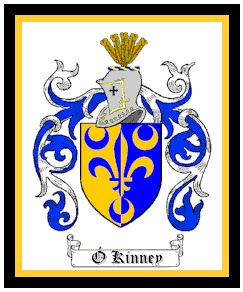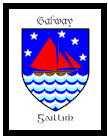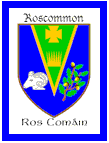Today in Gaelic is
|
In County Leitrim, Kenny has to some extent absorbed the local name Keeney. This is also spelled Keeny, Keany, Keaney, is fairly numerous in County Leitrim and southwest Donegal. Woulfe gave the irish form of Keany as O Cianaigh or perhaps more correctly OCaoinnigh. He lists elsewhere Mac Eanna, anglice MacKeany as a Wexford-Carlow surname and regards it as now hardly distinguishable from MacKenna. MacKeany, however is found in County Fermanagh as synonymous with Keany. A MacEanny is found in a County Roscommon Fiant of 1593. Keany, Kenny, Keeney, etc are probably a "Mac" not an "O" name. The "K" as in Keegan, Keogh and many others, being the "C" of Mac carried over to a proper name beginning with a vowel or silent "F".
Kenney is usually merely a variant spelling of Kenny, but it is also the name of some English immigrant families some who settled in the homeland of O'Kenny of Uí Máine.
The situation with regard to the main body of the Kennys of Galway and Roscommon is unusual because by a coincidence, it is also the name of a prominent English family from Somerset who, through intermarriage with County Galway families, become extensive landowners in the county and in Roscommon. These descend from Nicholas Kenny, Escheator General for Ireland under Elizabeth I, whose family was then established in Conty Wexford.
Thus, the leading families of the name in the Hy Many country, to which the O'Kenny sept belongs, are in fact of English origin. Rev. Arthur Kenny (1776-1855), the anti-Catholic controversialist, was probably one of these. On the other hand, Rev. Peter James Kenny, S. J. (1779-1849) founder of Clongoweswood College, was one of the most distinguished Catholic preachers and theologians of the nineteenth century. James Kenney (1780-1881) the dramatist, was born in Dublin, and his son, Charles Lamb Kenney (1821-1881) was born in Paris. James F. Kenney (b. 1884), was the author of the standard work Sources for the Early History of Ireland. Source: Edward MacLysaght, Irish Families, Dublin, Irish Academic Press, 1991, page 115.
|
|
|
|
Kinney : Variant of the Scottish Patronymic name Kenney derived from the Gaelic given name Cionaodha , of unknown origin, but likely composed of the elements cion = respect + Aodh = pagan god of fire. Occasionally Kenney is derived as an Irish Patronymic name through the Anglicizing of O'Coinnigh -- 'descendant of Coinneach . Variations are McKinney, McKenney, McKenna, McKinna , and McKennan , among others.
MacKinney: "This name is numerous in Ulster today; it is mainly found in counties Antrium and Tyronne. It is far more numerous now that it was a century ago - in 1866 there were 9 MacKinney births registered and in 1890 there were 42. The reason for this most unusual increase is that there has been a continuous tendency for the Scottish Mackenzie to become MacKinney in Ireland and it has also been used as a synonym of MacKenna. MacKinney is also the name of a sept of the Clan Mackinnon." More Irish Families, Edward MacLysaght, Dublin, 1996, page 139.
With few exceptions, your current surname may not be close to your historical surname. Many times, census takers and ship's clerks spelled your family name phonetically. Some examples below.
| Knowles | Ó Tnúthghail | Newell | O'Knowell |
| Cussen | Quishing | Cushion | Cushing |
| Henneberry | de Hynteberge | Henebry | Hembury |
| Kinney | O' Kenny | MacKinney | MacKenna |
| Magner | Magnier | Mangel | Magnes |
| Kiely | Queally | Kealy | Kelly |
Sept and Clan
The terms clan and sept have often been confused. Ireland never had a
well developed clan system like Scotland. "Sept" is more
appropriate as a collective term describing a group of persons or immediate
ancestors who bore a common surname and inhabited the same territory. Clan
is now used to indicate the family group. Source: Edward MacLysaght, Irish Families, Dublin: 1991. Bibliography
The use of a clan “coat of arms” is somewhat
controversial. In some countries, such as England and Scotland, the right
to bear arms is strictly regulated by law, and a coat of arms belongs only to an
individual and his direct heirs. In Ireland, however, the situation is
more complicated, and “sept arms” are recognized. (A sept is a branch of a
clan, such as the O’Kellys of Meath being a sept of Kelly.)
As stated by Edward MacLysaght, the first Chief Herald of
Ireland, “Briefly, then, the position is that many Irish coats of arms may be
displayed without impropriety by any person of the sept indicated if he really
does belong to that sept.” The arms to which MacLysaght refers and which
fall into the category of sept arms, include Kenny/Kinney.
1 John Burke and John Bernard Burke: General Armory of England, Scotland, Ireland and Wales. London: Harrison and Sons, 1884.
![]() The difficulty with establishing an
Irish pedigree is that the Central Repository of Ireland's Public Records was
set on fire and burned in 1922. The main bulk of the State, Domestic and
Ecclesiastical Records of the country were then destroyed.
The difficulty with establishing an
Irish pedigree is that the Central Repository of Ireland's Public Records was
set on fire and burned in 1922. The main bulk of the State, Domestic and
Ecclesiastical Records of the country were then destroyed.
Home | Ed Kinney | John Kinney | Wm. Kinney | Photos | Henebry Family | Dunn Family | Irish Clan Association



